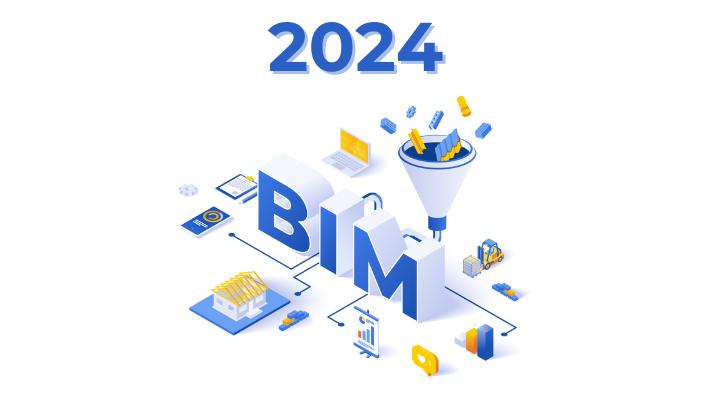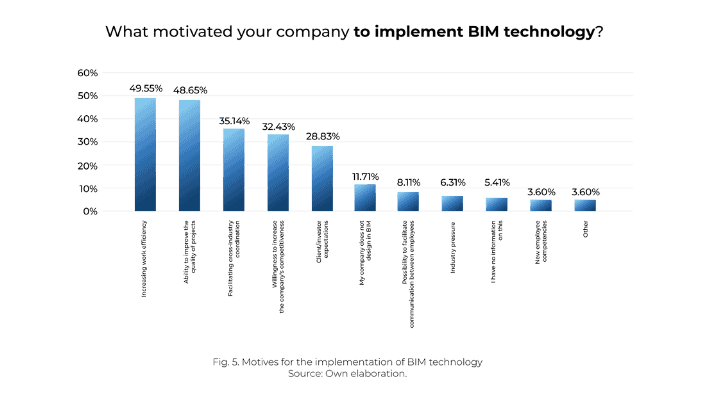6 Reasons why you MUST use BIM in your sales strategy in 2024

The construction industry is constantly evolving, and with it technologies such as Algorithmic Aided Design (AAD) and Building Information Modeling (BIM). Now it is time to consider BIM as an integral element of sales strategy.
Why? Here are 6 reasons, supported not only by your own observations, but also by the practical knowledge of industry specialists:
1. Market requirement and competitiveness
Contracts and orders in the construction industry increasingly make BIM a fundamental requirement. To stay in the game and compete effectively, using this technology becomes not only a benefit, but a necessity.
New trends and solutions emerge from time to time, but BIM has become more than just a novelty. This is no longer an option, but an absolute requirement in many contracts and orders. Companies that have not yet implemented BIM may encounter difficulties in winning new projects or even maintaining current contracts.
Customers expect efficiency, precision and modernity, and BIM is a key tool in meeting these expectations. Companies that ignore this trend may lose not only their competitiveness, but also their reputation in the industry. Investing in BIM technology is becoming not only a step towards modernity, but above all a strategy for survival and success in today’s dynamic construction environment.

2. Efficiency and quality of projects
Architects, as one of the first participants in the design process, had already noticed that BIM brings incredible benefits.
At the beginning, although the BIM implementation process requires some time and costs, these investments pay off many times over. The use of BIM allows you to shorten project implementation time, which is especially valuable in today’s dynamic business environment. Interdisciplinary coordination becomes more effective, and collisions between various project elements are noticed and resolved at an earlier stage, eliminating the need for later corrections, which saves time and money.
Moreover, working in BIM technology leads to higher quality projects. Building information modeling enables precise representation of each element, which translates into better visualization and understanding of the project by all interested parties.
Architects can easily experiment with different design solutions, which promotes creativity and innovation. Using ready-made 3D models and BIM libraries allows you to focus on design aspects, eliminating the need to manually enter data and construction materials. The entire design process becomes more fluid, which translates into the quality of the final results.
Moreover, investing in BIM technology opens the door to new markets and prestigious investments. Projects implemented based on BIM technology are quickly gaining notoriety not only at the national but also international level. It’s a great way to showcase your skills, services and products in the context of high-demand construction projects, which in turn contributes to your continued growth and success in the industry.

3. BIM affects the efficiency of designers’ work
The dynamic development of BIM technology goes hand in hand with the needs of architects who are always looking for effective tools to facilitate their work.
The introduction of parametric design and the use of various types of libraries and BIM models is becoming a key facilitation for designers. Ready-made 3D models allow you to save valuable time that would usually be spent searching for and manually entering data regarding building or finishing materials.
Companies that understand the importance of cooperation with designers decide to prepare their products in the form of ready-made libraries and 3D models. Thanks to this, designers have access to complete product information in one place, which allows them to be quickly used in the project.
4. Dynamic development of software supporting design
The design environment is gaining more and more innovative software that is intended to significantly improve the work of designers in various fields. These advanced tools based on algorithms and BIM technology are becoming key support for specialists in architectural design, engineering and industrial design.
The software not only reduces the time needed to prepare a project, but also enables designers to use a variety of functions such as automatic optimization, energy efficiency analysis and generation of alternative design variants. Thanks to this, designers are able to experiment with different concepts, quickly adapting to changing requirements and trends in their industries.
Often, these software also offer integration with product and material databases, which allows designers to access up-to-date information about available solutions on the market. This not only increases work efficiency, but also allows for better use of innovative and modern solutions in projects.
By providing work tools that speed up and facilitate the work of architects, construction manufacturers not only introduce innovative solutions, but also establish lasting contact with the design industry, creating a new sales channel.
The tool called BIM Ally Toolbox is a key instrument enabling direct interaction with the target group, i.e. designers.
Cooperation with architects is a key element of the construction product sales strategy. Architects are indispensable partners in the design process, and at the same time there is no design without the use of high-quality construction products.
This symbiosis between the architect and the construction manufacturer is the foundation of fruitful cooperation. By providing designers with materials in the form of 3D models containing comprehensive product information, we establish a valuable business partnership. In this cooperation, both parties benefit, creating a perfect example of a win-win strategy.
By implementing BIM Ally Toolbox, manufacturers also receive direct feedback on the projects in which their products are used. Statistics on the amount and type of building materials used, surface area and other data related to planned investments become a valuable source of information for producers. This data allows for better adaptation of the sales offer to current market needs, as well as for improving the company’s strategy.

5. Use your team’s competencies as a key competitive advantage
With the dynamic development of BIM technology, new challenges appear for construction companies.
The digital transformation that BIM brings requires adapting to the changing industry landscape. One of the key aspects of this transformation is the need to adapt both the organizational culture and employee skills to use advanced BIM tools. Companies that manage to respond to this challenge will have a chance not only to stay on the market, but also to gain a competitive advantage.
The introduction of BIM also creates new opportunities in the area of staff training and development. Companies can benefit from dedicated training programs that help employees achieve a high level of proficiency in using BIM technology. Investments in the development of employee competences are becoming a key element of the strategy of companies that want to take advantage of the full potential of BIM.
Additionally, a company implementing BIM must focus on cybersecurity aspects as transmitting, storing and sharing data in the cloud becomes an integral part of the BIM process. Protecting the confidentiality and integrity of data is becoming a priority, and companies must ensure that they apply the latest IT security standards.
All these changes require companies to be flexible, innovative and ready for continuous improvement.

6. The role of BIM in the private sector
Currently, the private sector is seeing the practical benefits of using BIM technology in construction projects.
These benefits include more precise planning, effective cost management and progress monitoring. Private investors increasingly require the implementation of BIM technology because it enables better control over the project and reduces the risk associated with unforeseen situations.
The use of BIM in the private sector also enables advanced analyzes related to sustainable development and energy efficiency. In addition to traditional financial aspects, investors pay attention to the impact of projects on the environment and society. Thanks to BIM technology, it is possible to understand these issues more precisely and make more sustainable design decisions.
In the context of communication, BIM enables investors to better cooperate with other project participants. Virtual building models enable a more interactive understanding of the project, which facilitates decision-making and effective communication with architects, engineers and contractors.
In short, the growing use of BIM technology in the private sector is not just a reaction to trends, but a practical necessity to ensure more effective and sustainable management of construction projects.

To sum up, the use of BIM technology is becoming a key factor not only in improving the efficiency of design processes, but also in gaining a competitive advantage in the construction market. It is not only an investment in technology, but also an investment in the future of the company.
All charts present data from the report “BIM and digital tools among designers” carried out in 2023.
link to report: https://bimally.com/reports/bim-and-digital-work-tools/

BIM ALLY TOOLBOX will equip your company with tools and services, thanks to which you will be able to effectively manage cooperation with both current and newly acquired designers.